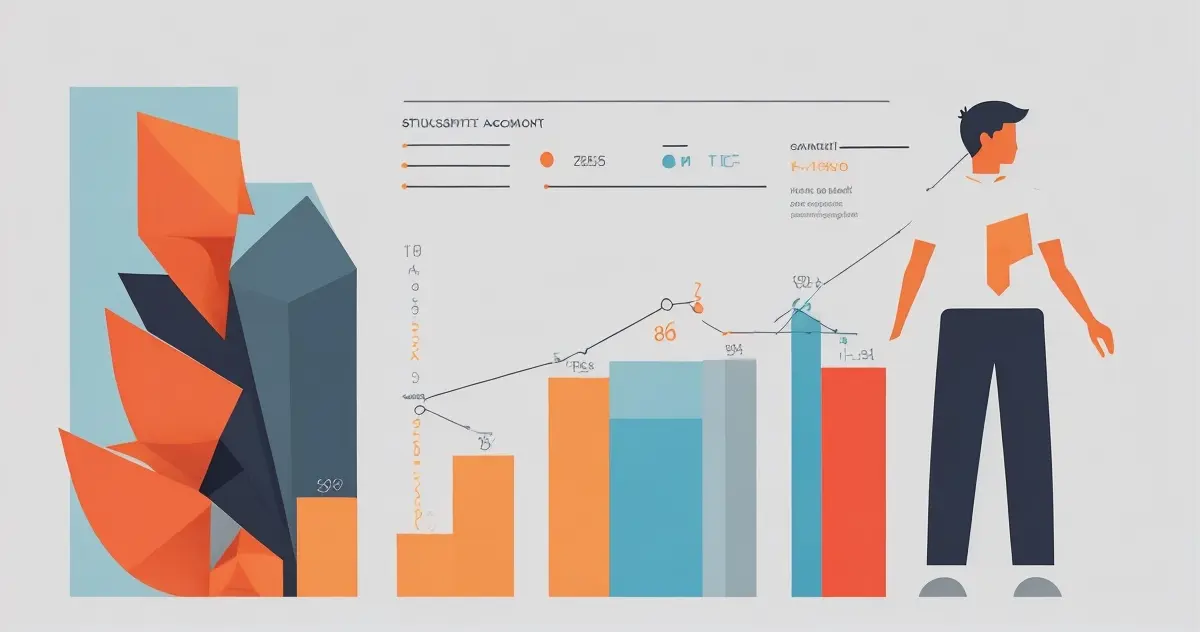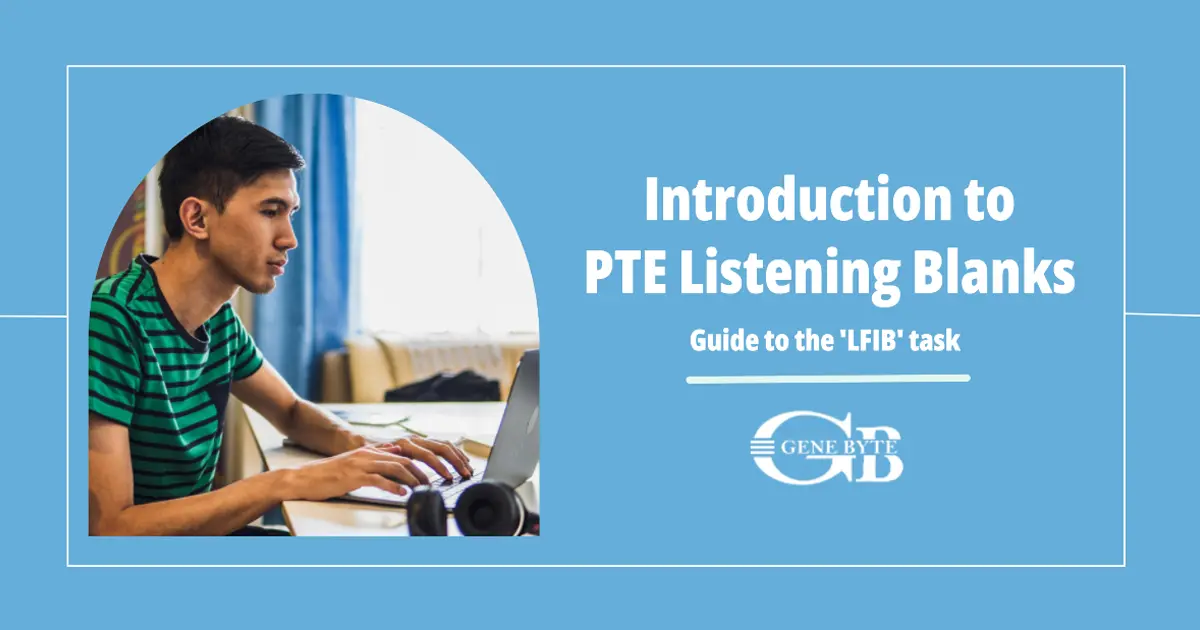Genebyte's innovative tools transform PTE Reading preparation, turning challenges into triumphs.
Are you fully equipped to guide your students through the Listening Section's Fill in the Blanks task? This crucial item, often a determiner of a student's success, requires a nuanced understanding and specific teaching strategies. At Genebyte, under the leadership of Reet, our Director with extensive experience in standardized English test preparation, we specialize in empowering educators for PTE, IELTS, and CELPIP. Our focus? To enhance your teaching methodology with cutting-edge SaaS solutions tailored for coaching institutes.
Imagine a classroom where your guidance turns challenging listening exercises into triumphs of comprehension and accuracy. This article delves into the subtleties of the Fill in the Blanks (Listening) question type, offering you insights and strategies from Genebyte's reservoir of knowledge. Positioned as a key resource for educators in the consideration phase of our content strategy, our goal is to transcend beyond mere information, aiming to revolutionize your approach to teaching this critical aspect of the PTE Academic exam.
The 'Fill in the Blanks (Listening)' component of the PTE Academic exam is a critical task that tests both listening and writing skills of test-takers. This unique question type presents a transcript with several gaps on the screen, and candidates are required to fill these gaps by typing the missing words they hear from a one-time audio recording. This task, typically comprising 2 or 3 items in the test, involves audio clips ranging from 30 to 60 seconds.
Our objective in discussing this question type is to provide a deep understanding of its dynamics, challenges, and importance in the PTE Academic exam. By delving into this aspect, we aim to equip teachers with essential insights that enable them to better prepare their students for this specific challenge. The Fill in the Blanks (Listening) task not only assesses a candidate's ability to comprehend spoken English in an academic context but also their skill in accurately capturing and conveying this information in written form. It's a blend of listening for specific details, such as proper nouns and repeated nouns, and the ability to quickly and accurately transcribe these details.

Introduction to Fill in the Blanks (Listening) in PTE Academic
Overview of the Question Type
'Fill in the Blanks (Listening)' in PTE Academic is a distinctive question type designed to assess both listening and writing skills of the test-takers. In this task, candidates encounter a transcript displayed on the screen with several gaps. The challenge lies in listening to an audio recording, typically lasting between 30 to 60 seconds, and accurately typing the missing words in each gap. This section of the test requires a keen ear and a quick response, as test-takers are only allowed to listen to the audio once.
Significance in PTE Academic
This task plays a vital role in the PTE Academic exam, serving as a practical measure of a candidate's ability to process spoken English in an academic context and translate it into accurate written form. It not only tests the comprehension of spoken language but also evaluates the ability to capture this information in writing under time constraints. This question type is particularly important because it mirrors real-world scenarios where understanding and recording spoken information is essential.
Skills Assessed: Listening and Writing
The dual focus on listening and writing makes this task a comprehensive measure of two critical communicative skills. It assesses a range of subskills, including the ability to identify words and phrases appropriate to the context, understanding academic vocabulary, comprehending both explicit and implicit information, and following an oral sequencing of information. The task also evaluates the capability of writing from dictation, using appropriate words and phrases in the context, and employing correct grammar and spelling. Each correct word, spelled accurately, contributes to the scoring, emphasizing the importance of precision in both listening and writing.
Genebyte's B2B SaaS Solution: Enhancing Teaching Strategies
At Genebyte, we understand the complexity and importance of this task in the PTE Academic exam. Our B2B SaaS solutions are designed to empower teachers with tools and strategies to better prepare their students for this challenge. By integrating our technology into their teaching methods, educators can offer more targeted and effective training, ultimately leading to improved student performance in the 'Fill in the Blanks (Listening)' section of the PTE Academic exam.

Understanding the Task Structure of Fill in the Blanks (Listening) in PTE Academic
Description of the Task Format
The 'Fill in the Blanks' is also a task in the Listening section after Multiple-choice, Choose Multiple Answer. Here, test-takers are provided with a transcript on the screen, featuring several gaps that they must fill in. This task requires them to listen attentively to an audio recording and type the missing words into each gap. The task format is straightforward yet demands a high level of concentration and quick response.
Audio Characteristics: Length and Nature
Each audio clip in this section varies in length, typically ranging from 30 to 60 seconds. These recordings are designed to mimic real-world academic scenarios, where candidates must extract specific information from spoken text. The audio plays automatically after a brief countdown, and candidates have only one opportunity to listen to it, making it crucial to stay alert and focused 34†source.
The Role of Transcripts in the Task
Transcripts accompanying the audio recordings are pivotal in this task. They not only provide context to what is being heard but also serve as the framework where candidates need to fill in the gaps. The transcript contains up to seven blanks, and the test-taker's job is to identify the missing words as they listen to the recording. This format tests their ability to correlate written and spoken language effectively.
Number of Items Typically Encountered
In a typical PTE Academic test, candidates can expect about 2 or 3 'Fill in the Blanks (Listening)' items. This number is manageable yet significant enough to impact the overall score. Each correctly filled blank contributes to the score, making every item an important opportunity to gain points.

Challenges Faced by Students in this Question-type in PTE Academic
Identifying Common Difficulties in Listening
One of the primary challenges students face in the 'Fill in the Blanks (Listening)' task is the limited time available to comprehend and process the audio. With recordings played at normal speed and only once, students must quickly identify key words and phrases. The task requires intense concentration, as missing even a single word can lead to incorrect or incomplete answers. Students often struggle to maintain focus throughout the entire audio, especially when dealing with complex academic vocabulary or dense information.
Challenges in Transcribing Spoken to Written Word
Another significant hurdle is transcribing the spoken word into written form accurately. This requires not only a good understanding of the language but also the ability to spell words correctly. The pressure of typing words in real-time as they are heard adds to the difficulty, as students must balance listening and typing simultaneously. Many students find it challenging to keep up with the pace of the audio while ensuring that their transcription is error-free.
Dealing with Academic Vocabulary and Context
The academic nature of the audio recordings introduces another layer of complexity. Students must be familiar with a broad range of academic vocabulary and be able to understand the context in which these words are used. The task often includes proper nouns, technical terms, and phrases that are specific to certain fields of study. Recognizing these words and understanding their relevance within the context of the audio can be daunting for students who are still developing their academic English skills.

Implications for Teaching this Question-type in PTE Academic
Importance for Teachers to Understand the Listening Fill in the Blanks
As educators, understanding the 'Fill in the Blanks (Listening)' task in PTE Academic is crucial. This task not only assesses students' ability to listen and write but also tests their proficiency in handling academic vocabulary and context. For teachers, a deep comprehension of this task means they can better prepare students for the challenges it presents. It's about equipping learners with strategies to swiftly identify key information and accurately transcribe it. This knowledge is essential for teachers to develop effective training modules and practice exercises that mirror the task's demands.
Influence on Students' Overall Performance in PTE Academic
The performance in this task significantly impacts the students' overall scores in the PTE Academic exam. As each correctly filled blank contributes to the scoring, the task holds substantial weight in the assessment of Listening and Writing skills. Thus, effective teaching strategies focused on this task can play a pivotal role in enhancing a student's overall performance in the exam. Teachers must emphasize the importance of active listening, quick processing, and accurate transcription skills.

The Scoring System Explained for Fill in the Blanks (Listening) in PTE Academic
Criteria for Scoring: Content Accuracy and Spelling
The 'Fill in the Blanks (Listening)' section of the PTE Academic exam is intricately scored based on content accuracy and spelling. Each response is evaluated for the inclusion of all the correct words, as heard in the audio recording, and their accurate spelling. This means that each correctly identified and spelled word earns the student one point. The task's scoring emphasizes the importance of not only understanding the spoken words but also accurately transcribing them, reflecting a comprehensive assessment of both listening and writing skills.
Understanding the Impact on Listening and Writing Scores
Like SST and WFD, this question type significantly influences the test-taker's scores in both the listening and writing sections. It tests various subskills, such as the ability to identify contextually appropriate words and phrases, understand academic vocabulary, comprehend both explicit and implicit information, and follow an oral sequence of information. The task also assesses the student's ability to write from dictation, using correct grammar and spelling. Therefore, a student's performance in this section can impact their overall proficiency in both listening and writing components of the PTE Academic exam.
Partial Credit Scoring and Its Implications
The PTE Academic employs a partial credit scoring system for this task. This means students receive points for each correctly filled blank, without any penalty for incorrect answers. For instance, if a student correctly fills 5 out of 7 blanks, they will earn 5 points, as no deductions are made for the incorrect or unfilled blanks. This scoring system encourages students to attempt all blanks, as guessing can potentially earn them points without the risk of losing marks for incorrect responses.

Actionable Tips for Teachers
- Practice Active Listening: Encourage students to practice active listening skills. This involves focusing on the audio, understanding the context, and identifying key words and phrases.
- Simulated Practice Tests: Regularly engage students in simulated 'Fill in the Blanks (Listening)' exercises that mimic the actual PTE Academic test environment. This helps students get accustomed to the format and time constraints of the exam.
- Emphasize on Spelling and Grammar: Stress the importance of correct spelling and grammar in students' responses, as these are crucial for scoring in this task.
- Use of Technological Tools: Integrate advanced learning tools that offer immediate feedback on practice exercises, helping students to identify and rectify their mistakes promptly.
Mastering the 'Fill in the Blanks (Listening)' section in PTE Academic is a balanced act of sharpening listening skills and perfecting the art of accurate transcription. For educators, the challenge lies in equipping students with the right skills and strategies to excel in this task. By focusing on active listening, precise transcription, and regular practice, teachers can significantly enhance their students' performance in this crucial aspect of the PTE Academic exam.
Genebyte's Role in Elevating Teaching Methods:
Genebyte's B2B SaaS solution emerges as an essential tool for coaching institutes dedicated to PTE Academic preparation. Our platform provides a comprehensive suite of resources tailored to the 'Fill in the Blanks (Listening)' task, including simulated tests, instant feedback mechanisms, and analytics to track student progress. After this important task, candidates move to the MCQ-style Highlight Correct Summary task. By leveraging Genebyte's technology, educators can offer a more focused and effective training regime, ultimately leading to higher scores and improved outcomes for students.
Discover how our innovative B2B SaaS solutions can transform your teaching approach and elevate your students' PTE Academic performance. Visit our website to learn more and join the community of educators who are redefining success in standardized English tests.
In summary, Genebyte stands as a beacon of innovation and expertise, empowering educators and students alike in their quest for PTE Academic success.
Embark on a journey of academic excellence with Genebyte!
Frequently Asked Questions
PTE Academic's Fill in the Blanks (Listening) is a task where students listen to a recording and type missing words into a transcript displayed on the screen. It assesses their ability to comprehend spoken English and accurately transcribe it, focusing on their Listening and writing skills.
The format involves a transcript with several gaps displayed on the screen. Students listen to an audio recording, usually 30-60 seconds long, and fill in the gaps with words they hear. The task tests listening comprehension and transcription accuracy.
Scoring is based on content accuracy and spelling. Each correctly identified and spelled word from the audio earns the student a point. This task influences both the listening and writing components of the PTE Academic score.
Scores are calculated by the number of correctly filled blanks with accurate spelling. Each correct word spelled correctly earns one point. Partial credit is given, so students are encouraged to attempt all blanks.
Marks are allotted for each correct word typed in the blanks. There's no negative marking, so partial credit is awarded for each correctly filled blank, with no deductions for incorrect answers.
The number of questions varies, but each session typically includes several Fill in the Blanks (Listening) tasks. Each task contains multiple blanks to fill, contributing to the overall score.
The duration of each Fill in the Blanks (Listening) task ranges from 30 to 60 seconds per audio clip. The time to complete the task depends on the length of the recording and the number of gaps in the transcript.
This task comprises an audio recording and a written transcript with blanks. Students listen to the recording and fill in the blanks with words they hear, focusing on accurate transcription and spelling.
Effective techniques include practicing typing speed, honing spelling skills, and familiarizing oneself with common PTE academic vocabulary. It's also beneficial to develop a keen ear for different accents and speech patterns.
Academic vocabulary plays a significant role in this task. Familiarity with a wide range of academic terms and their context helps students understand and accurately transcribe the audio, leading to better scores.
Best practices include regular listening practice with diverse academic recordings, mastering quick and accurate typing, and improving vocabulary. Additionally, simulated practice tests under exam conditions are highly beneficial.
Enhancing focus can be achieved by practicing in a distraction-free environment, breaking down audio into smaller segments for practice, and developing concentration techniques. Regular practice with varying audio types also helps build focus.
